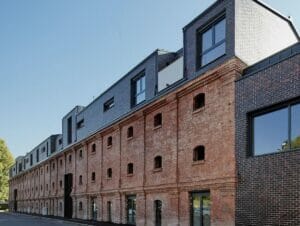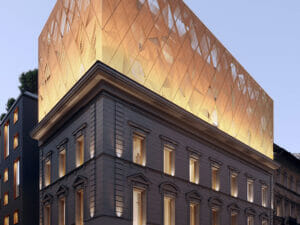
The construction sector loves to combine opposites. Sustainable construction is about finding a common denominator for the needs of urbanisation while caring for the environment. The renovation of old buildings, on the other hand, combines modern technologies with traditional, historic forms. Here we deal with the latter combination, and have 6 examples to show you where tradition meets modernity. When these two elements come together, they create not only a beautiful but also a functional, ecological building.
Renovation or new construction?
The trend toward revitalising existing buildings is just one way of making cities more resident-friendly. Contemporary retrofit techniques enable to complement the pre-existing structures with modern amenities and let the buildings not only maintain their historic character but also help designers in choosing a low-emission path for creating spaces.
This type of revitalisation is the kind of activity that has even more advantages. We could list a number of them:
- the opportunity to create an investment in an attractive location, where the construction of new buildings is very often impossible,
- faster completion of the investment – based on an already existing structure, the required activity is shortened by the time necessary for its design, creating foundations, erecting walls and ceilings, etc.,
- no need to invest in the constantly rising prices of building materials, which we would have to face if we were building from scratch,
- reduced carbon footprint in component manufacture, the construction process and the transport of materials to the location of the investment.
Investing in the revitalisation of existing buildings is becoming one of the best ways to create something that not only historically fits the urban landscape, but also provides tangible benefits for investors.
Discover 6 inspiring examples where the application of Aluprof systems gave old buildings a new life.
1. Riverside House, Salford
Built in the late 1890s, this place was formerly used as a tavern, where British army veterans met. Revitalisation project has restored its glory and turned it into an office building with over 1,400 square metres of space with a food retailer and riverside terrace at ground floor.

2. Bodmin Jail, Bodmin
Places like the former prisons are suitable for retrofit projects due their solid existing structures, they require little structural maintenance. However, giving a prison a new function is a challenging task because of their limited spatial organisations. However, the designers of the Bodmin Jail in the UK skillfully overcame this challenge by turning it into an hotel and museum. The project included the use of the Aluprof MB-Slimline series, a window system which is flexibly adapted to the existing openings of the heritage building .

3. Crusader & Phoenix Mill, Manchester
The MB-Slimline system has also been used in the renovation of the Crusader & Phoenix Mill in Manchester. The historic mill has been transformed into a residential space, offering buyers elegantly-styled lofts in a former industrial building.

4. Norblin Factory, Warsaw
Former factory buildings are ideal for transformations into a set of remarkable service facilities. This is what took place at the Norblin factory in Warsaw. The revitalisation and reconstruction process, using Aluprof MB-SR50N HI+, MB-86US SI and MB-86 SI systems, allowed it to gain over 40,000 square metres of space for offices, for a cinema, for eating, wellness and fitness and, of course, for a museum.
5. Jazz Loft Apartments, Budapest
The application of the MB-70 and MB-86 SI window and door systems transformed former mill buildings in Budapest into spacious, modern apartments, and all in one of the most thriving districts of the Hungarian capital. The combination of modern construction technology in a 19th century structure not only restored the building to its full functionality, but it also created another historic element for the city.

6. Hard Rock Hotel, Budapest, Hungary
While we are in Hungary, it would be inexcusable not to mention one of the most interesting revitalisation projects in the city of Budapest – the Hard Rock Hotel. Located in the 6th district of the city, the renovation works involved the use of MB-SR50N HI+ and MB-86 SI systems, which helped to create a total of 6 floors with 136 rooms, a fitness room, a modern lobby bar and a restaurant. One of the characteristic elements worthy of mention is the glazed “Rooftop”, a remarkable multifunctional entertainment space.

Let’s build a better future
In its development strategy, Aluprof focuses on environmental protection through the use of modern, low-emission building technologies. This trend can be seen in the way it approaches the production of window, door and façade systems. Thanks to the use of aluminium, it effectively reduces the amount of pollutants generated, providing durable products which are resistant to weather conditions and enable their further processing and use in subsequent investments.
A special line of products adapted to the needs of revitalisation allows Aluprof to actively participate in improving the quality of life in city centres. Renovating old buildings through the use of eco-friendly solutions leads to a reduction in the carbon footprint for the construction sector. This ensures a better future, not just for the historical buildings, but also for us – their users.
Article sponsored by Aluprof
ALUPROF UK LTD
Unit A5,
Altrincham Business Park
Stuart Road
Altrincham, WA14 5GJ
Cheshire, United Kingdom
+44 161 941 4005
[email protected]
aluprof.co.uk

